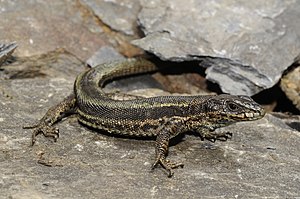Iberolacerta
| Iberolacerta | ||||||||||||
|---|---|---|---|---|---|---|---|---|---|---|---|---|

Val d'Aràn mountain lizard ( Iberolacerta aranica ) |
||||||||||||
| Systematics | ||||||||||||
|
||||||||||||
| Scientific name | ||||||||||||
| Iberolacerta | ||||||||||||
| Arribas , 1999 |
Iberolacerta is a genus of the real lizards (Lacertidae) that occurs disjointly in mountainous regions of southern Europe. The distribution area includes central Portugal, central and northern Spain, the French Pyrenees , northwestern Croatia , Slovenia and the adjacent areas of northern Italy. I. horvathi occurrencesin southern Germany are likely due to human exposure.
features
Iberolacerta species are small lizards with a head-to-trunk length of up to 85 mm. The head and body are slightly flattened. Adult females grow larger than males. There are seven to nine teeth on the premaxillary , the wing bone is edentulous. The hemipenis of the males has crown-shaped tubercles and hook-like spines.
The basic color of the lizards is brown or gray, less often green or bluish. The back is patterned with stripes, ribbons, a dark stripe along the center of the back, or two rows of dots. The males of I. cyreni, I. galani and I. monticola have a different color from the females and have green backs and marbled flanks. I. monticola, I. galani and I. martinezricai have a bruise on the shoulder region . The ventral side is whitish, light yellow, orange-yellow or green in color, sometimes with a bluish or pink tinge. The transition between the color of the abdomen and the flank is marked with blue dots, with the exception of I. aurelioi . The throat is usually the same color as the belly. Only in I. aurelioi and I. horvathi is the throat white, while the belly is yellow. The belly side can be monochrome or have spots. Young animals often have bright greenish or blue tails.
habitat
Most Iberolacerta species occur exclusively in the mountains and often at high altitudes. They prefer rocky habitats with smooth rock surfaces or live on and under rubble. Only I. monticola lives in the north-west of Spain in damp valleys and cliffs at sea level.
Reproduction
During mating, the males bite the flanks of the females. A clutch usually consists of three to ten eggs. The embryos in freshly laid eggs are often well developed in the species native to the Pyrenees, similar to that of the ovoviviparous forest lizard ( Zootoca vivipara ). The time to hatch is relatively short and is 30 to 33 days in captive offspring.
species

- Spanish mountain lizard ( Iberolacerta cyreni (Müller & Hellmich, 1937))
- Galan's mountain lizard ( Iberolacerta galani Arribas, Carranza & Odierna, 2006)
- Croatian mountain lizard ( Iberolacerta horvathi (Méhely, 1904))
- Martinez Rican mountain lizard ( Iberolacerta martinezricai (Arribas, 1996))
- Iberian mountain lizard ( Iberolacerta monticola (Boulenger, 1905))
Subgenus Pyrenesaura (species of the Pyrenees)
- Val d'Aràn mountain lizard ( Iberolacerta aranica (Arribas, 1993))
- Aurelio's Mountain Lizard ( Iberolacerta aurelioi (Arribas, 1994))
- Pyrenean mountain lizard ( Iberolacerta bonnali (Lantz, 1927))
literature
- E. Nicholas Arnold, Oscar Arribas, Salvador Carranza: Systematics of the Palaearctic and Oriental lizard tribe Lacertini (Squamata: Lacertidae: Lacertinae), with descriptions of eight new genera (= Zootaxa . 1430). Magnolia Press, Auckland 2007, digital version (PDF; 2.76 MB) .